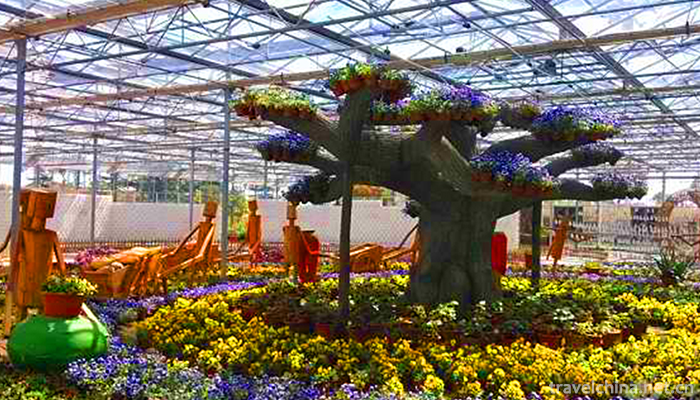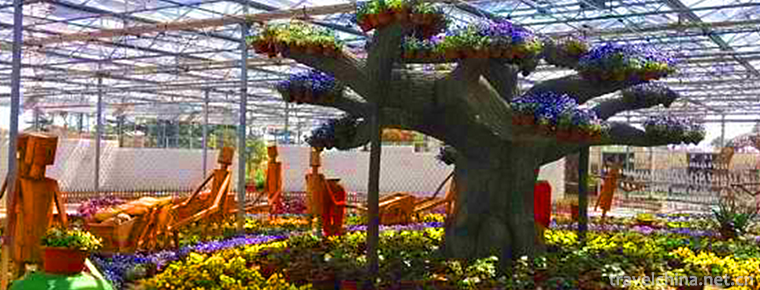Shanghai Metropolitan Vegetable Garden
Shanghai Metropolitan Vegetable Garden is located on the Bank of Hangzhou Bay, Bay Town, Fengxian District. It is about 50 kilometers away from the center of Shanghai and covers an area of 5,000 mu (400 Mu as the main visiting area). It is a national 4A tourism scenic spot, a national agricultural tourism demonstration site and a popular science education base in Shanghai.
Garden Project
Here, you can see more than 200 kinds of fresh and exquisite vegetables, experience the pleasure of planting, harvesting, picking, cooking and tasting vegetables, and learn about the history and culture of farming, vegetable culture, modern agricultural planting technology, planting patterns, agricultural products processing and other related knowledge. With the new appearance of vegetables, you can feel a new way to relax your body and mind, return to nature and enjoy. Be healthy and happy. Located in the recreation area west of the park, it has ecological maze, aquatic vegetable area, grassland football, beach volleyball, kite flying and other scenic spots.
Shanghai urban vegetable gardens rely on the poetic and picturesque idyllic scenery, rich humanistic landscape, take vegetables as the soul, green, natural and healthy as the foundation, with the help of modern vegetable cultivation techniques, use artistic portrayal techniques, integrate the charm of Jiangnan gardens of bridges, running water and pavilions, and display the unique farming culture and natural beauty of vegetables in Jiangnan, which is a veritable vegetable. Exhibition Hall.
Location
Shanghai Metropolitan Vegetable Garden is the first vegetable theme park in China.
Main venues
It has five main venues: Farming Exposition Hall, Boya Agricultural Garden, Xinxiang Vegetable Garden, Qigua Vegetable Garden and Four Seasons Orchard.


-
1.RenminbiChinese yuan
The legal currency of the People's Republic of China is Renminbi. The People's Bank of China is the competent organ of the state in charge of the management
Time 2018-11-13 -
2.Yin and yang
There are three characteristics of yin yang philosophy: unity, opposition and interaction. In thinking, it is an inseparable node of arithmetic and divination.
Time 2018-11-13 -
3.Yuanyi Shuangfeng Lake International Tourist Resort
Yuanyi Shuangfeng Lake International Tourist Resort in Anhui Province is a high-level tourist resort integrating Golf and leisure. Located in the beautiful scenery, with a total area of more than 2000
Time 2018-12-23 -
4.Tianjin Dule Temple
Dule Temple, also known as the Great Buddha Temple, is located in Jizhou District, Tianjin, China. It is one of the three remaining temples of Liao Dynasty in China and one of the famous ancient build
Time 2019-01-08 -
5.Bo dance
Horqinbo dance, a primitive religious dance, is a form of Mongolian Bo (Shaman) "Xingbo" (Dancing God) and sacrifice. It is characterized by the combination of inspiration,
Time 2019-04-04 -
6.Production Techniques of Pu er Tea
Pu'er tea production technology, also known as tribute tea production technology, has been formed through thousands of years of practice. The basic procedures are as follows: sacrificing the God of te
Time 2019-06-09 -
7.Qinghai Han Minority Folk Minor
Qinghai Han folk minor is one of the genres of Chinese folk songs. Generally speaking, it refers to folk songs and dances popular in town fairs. Through the spread of the past dynasties
Time 2019-06-10 -
8.Guozhuo Dance in Shannanchang
Shannanchang Guozhuo Dance is a kind of waist drum, which originated in Dabu (now Jiacha) area. Legend has it that in the mid-eighth century, with the help of Buddhist masters such as lotus and peanut
Time 2019-06-13 -
9.Shaoyuan mythological group
Shaoyuan myth group is one of the ancient Chinese myths and legends. Refers to the general name of the creation myths and mythological prototypes circulated in Shaoyuan Town, Jiyuan City, Henan Provin
Time 2019-06-14 -
10.Jumping Cao Gai
Caogai jumping is prevalent in Baima Tibetan area of Pingwu and Nanping counties. It is held on the sixth day of the first month of the lunar calendar every year. Cao Gai is a Baima Tibetan phonetic t
Time 2019-06-21 -
11.Yongkang Drum Ci
Yongkang Drum Ci is a rap art in Yongkang area of Zhejiang Province. It belongs to the form of singing and talking, which is mainly composed of singing. Because of the use of local dialect performance
Time 2019-07-14 -
12.Yugur Costume
Yugur costume is the traditional costume of Yugur people. Both men and women of Yugur nationality wear long gowns with high collars and large skirts. Men wear red and blue belts with waistknives, sick
Time 2019-07-16